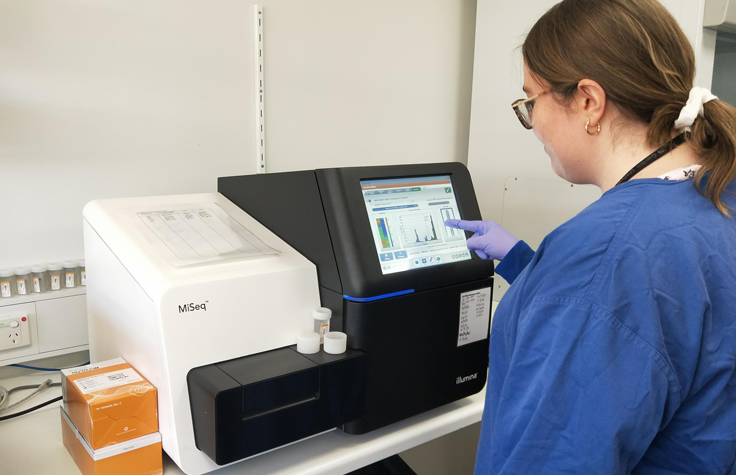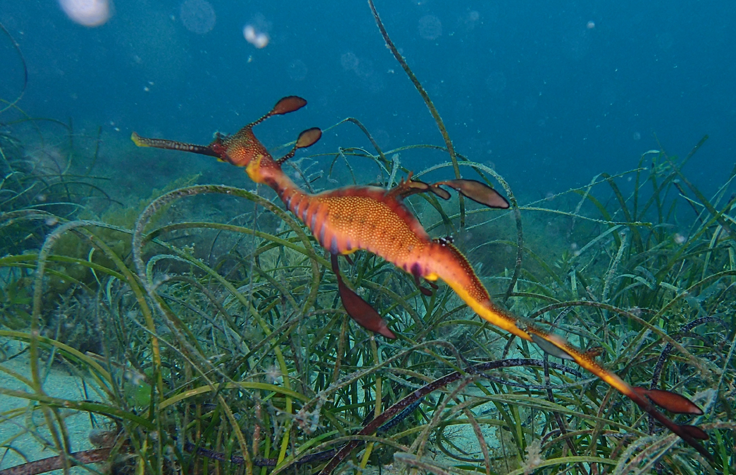eDNA Frontiers Is Demystifying Earth’s Environmental Biodiversity Through NGS
Introduction
Shane Herbert,
Business Manager, eDNA frontiers,
Curtin University
Shane Herbert is the business manager at eDNA frontiers, a research service group out of Curtin University in Australia.
As organisms move through the world, they shed genetic material. Cells from their fur, skin, scales, and other sources end up in the environment, providing genetic clues about what organisms exist there. For a long time, this “environmental DNA” or “eDNA” went unappreciated by researchers. Now, eDNA frontiers, a research service group out of Curtin University, has figured out how to wield environmental DNA to help industry, government, and researchers study biodiversity and ecosystems.
The group, based in Perth, Western Australia, is analyzing eDNA to reveal what organisms exist in various habitats. eDNA frontiers takes samples from the environment and then uses Illumina’s NGS technology to sequence the DNA contained in them. The sequencing data can identify the organisms present in the eDNA sample and thus, which ones have been in that location.
eDNA frontiers says the technique is faster and can be more comprehensive than scientists’ traditional methods of collecting and identifying organisms. The applications of eDNA are also vast—they include biodiversity audits, monitoring for invasive species, diet analysis, finding rare and elusive organisms for conservation, and more. “We've got clients from all around the world doing environmental impact assessments, biodiversity studies, and many other applications,” says Shane Herbert, business manager at eDNA frontiers. “And there are still many new applications we're coming across.”
iCommunity spoke with Shane Herbert about eDNA frontier’s work with environmental DNA, its current applications in countries like Thailand and Australia, how eDNA might be used in the future, and why Illumina NGS technologies like MiSeq and iSeq are essential for sequencing eDNA.
Q: What is eDNA? How can it be used to measure biodiversity and study the ecosystems around us?
Shane Herbert: All living organisms leave behind deposits of themselves—skin cells, scales, hair, feces—which hold genetic material. Their abandoned DNA contains regions that tell scientists not only about the organisms themselves, but also their taxonomic information. We can target these regions in the collected eDNA, sequence them, and then find a taxonomic match in global DNA databases.
"By doing it that way rather than using a qPCR method, you get information not just about one species, but all the species targeted by that assay. You end up with a broader list of the organisms living in that environment and this gives you more interpretive power."
You pick up things you wouldn’t ordinarily be able to see, such as organisms in larval stages or elusive organisms that hide during all stages of their development. Virtually all of them leave DNA traces in water or in other mediums, which makes them detectable. It’s a great method for quick and economical audits of biodiversity.
Biodiversity audits are currently the main use of eDNA, but its applications are growing. You could go into an environment with little idea of what's there and target it with a general or narrow assay. If you're looking more generally, you could use a targeted nuclear gene like 18S to find all the eukaryotes, or you can use a more specific FISH assay to narrow it down to the species level. These can be used to guide interpretations in environmental impact statements when disruptions to ecosystems occur. Or you can go hunting for invasive species or rare and elusive species. It's great for diet analysis too.
Q: What are the biggest challenges of working with eDNA?
SH: The typical eDNA samples we handle are filtered water, which is a water sample that we filter onto a membrane and then collect the biological material in it. But it’s important to think about how you do your sampling.
If you're looking for a marine species, can you pick it up in the water? Or do you have to take a scraping to detect it? Do you do replicates and if so, in which locations? Then of course there’s extraction.

A researcher collecting a sea water sample, the water sample is then filtered onto a membrane and the biological material in it is collected and processed at eDNA frontiers.
You can’t just assume your extraction method covers everything. You need to make sure that the DNA in the cells you've collected can be made available for analysis. The other issue with environmental samples is that you're typically dealing with degraded material. The cell is in the process of breaking down, so you're not likely to find a whole genome—it’s going to be in little fragments.
Another challenge is just how many species exist in the world. There are an enormous number of unknown organisms. We run all our samples against GenBank as well as custom databases, and the number of unknowns is still incredibly high. But we could still match our unknowns in the future when a species’ DNA is finally sequenced and entered into genetic databases. This remains a global biodiversity “to-do.”
Q: What role is NGS playing in eDNA research? What advantages does NGS provide compared to the qPCR method or even PCR?
"You can be confident a positive is true since the target sequence is there in the data, and if there are sequence variants that otherwise knock out a qPCR assay, you’ll see it and rescue a false negative. This is a major advantage with NGS where we can see the variation within the amplicons that we sequence."
SH: With NGS, you get a lot of information. It's a broader result, it's more identifications per sample. It gives you greater interpretive power to look at your data and find out what's there, what’s missing, and what patterns correlate with other sampling area data, such as if it’s polluted or not. You can still get the presence or absence of a particular organism, say an invasive species or animal of conservation interest, with good sensitivity. You're getting that information, plus everything else. The extra information just adds to the environmental picture of where the sample came from and that is quite interesting.
With qPCR, you use a probe binding assay. The output is a fluorescent signal, a yes or no. All your effort has to go into the development of that assay, to make sure your signal is going to be what you want it to be. If you happen to amplify something else that shares the same primer or probe sequence, then you don't have any way of knowing if the signal is off target. Equally, if qPCR is negative then you assume it is not present. This is where the sequence information is quite useful because it is its own positive control.
It’s interesting in a biomonitoring study where we take samples from a large geographical region and you see a bit of sequence variation across the region. It can start telling you about the connectivity between those sites. It's not population genomics, but it's still useful information.
Q: What is the NGS method you use to analyze biodiversity in environmental DNA samples? What is the metabarcoding approach?
SH: The reason we don't do something like shotgun sequencing in an environmental sample is because they're full of bacteria and unicellular organisms. If you're not looking at them, it's just chewing up your sequence yield. What you're really interested in is hiding in the one or two percent of the total sample. Metabarcoding allows you to screen everything else out and just look at what you're interested in with greater definition.
Also, shotgun sequencing looks at the genomic, mitochondrial, and chloroplast DNA from all the organisms in the sample. That’s a lot of DNA. It’s also mostly unknown because it comes from species that are barely known or described. The small numbers of those that are taxonomically identified may have had only a couple of barcode regions sequenced and loaded to GenBank. So even with all the sequencing data, you can’t use it to identify much. Metabarcoding is like using a special lens where you amplify only the DNA that you can match with in GenBank and deliberately exclude all the DNA that’s unhelpful. A whole genome could be reduced from 3.2 billion base pairs (i.e. humans) down to approximately 200 to 300 base pairs in a metabarcode target.
Q: What NGS system is your institute is currently using? What is the reason that you’re using this system?

Illumina Next-Generation Sequencing technologies like the MiSeq and iSeq systems are essential for sequencing eDNA, and are compatible with biomonitoring needs.
SH: We're a big fan of the MiSeq. We've got a couple of those. The main reason we use it is the sequencing length. Up to 600 cycle, 2x300, that covers all the barcodes we need to work with. They're a bit longer than the other systems Illumina has that can only do 2x150, which isn’t long enough for some of our barcodes.
Our MiSeqs run around the clock and they're very nice little machines. We've also got an iSeq, which we bought specifically for more mobile barcoding methods. We put it in a protective case that's on wheels so that we could move it around, plug it in, load up samples, and sequence on-site. That was an interesting little experiment and the system worked very well. We even put it on a boat—the collaboration team went out and collected samples in the ocean and did sequencing at sea. I think the iSeq is quite good, it's quite a robust little system. But certainly MiSeq is our workhorse.
Q: What are the limitations of eDNA sequencing?
SH: We don't get individual information on a specific organism nor are we able to identify which animal has been where. Sequence variants are a useful tool for connectivity information of a species, but it’s not population genomics information. We often get asked if eDNA can do those things and for the moment it cannot. It’s also not always possible to get to species level and this is occasionally a biology issue—two or more species share the same sequence and we can’t tell them apart. There is also the “unknowns” problem. This is always going to be a limitation in a DNA analysis until all organisms on Earth have a barcode sequence.
Abundance is another issue that eDNA metabarcoding struggles with. This is related to the complex PCR the method does, which can introduce biases in the final products. But it’s also a biology issue. For example, if you're looking at fish in a pond, there might be one large fish and fifty small fish. Smaller, younger fish don't shed as much. Larger, older fish shed lots of cells and release eDNA at a higher rate. So while we can sequence and count out the sequence reads, biology influences the result and it's not necessarily going to be accurate. We can estimate a relative abundance, but it's just not something we tend to rely on. Ironically, qPCR is slightly more helpful in that respect. But even then, it still needs to be assessed for every type of organism.
Q: What projects is eDNA frontiers currently working on?
SH: There are a couple of great examples that are pertinent to the Southeast Asia region. Shipping and invasive species is a big one—the chance of transfer or translocation of invasive marine species is on a lot of people's minds. There’s been interest in invasive species for a long time, so they are already taxonomically identified and sequenced. So, there's good context to use for an eDNA study.

eDNA is a great way of doing biodiversity audits on organisms without having to catch and kill them such as species like the weedy seadragon which is endemic to Australian temperate marine waters.
In the ports where ships end up after journeys from elsewhere, eDNA gets sampled using floating arrays which have settlement plates on them that allow algae and crabs and whatnot to live on them. Maybe two months or six months later they get collected, the biofoul is scraped off, and then we test them. We first use a generic assay in a triage system to see if an invasive species is present. If there is one, then we do another series of tests to confirm whether a specific invasive species is there. Ultimately, an ongoing eDNA biomonitoring study helps support the port’s resource management plan by allowing them to deploy remedial actions when needed, rather than generically applying them all the time.
Another application for eDNA is happening on oil and gas rigs in the Thailand Sea. It’s a big project one of the professors at Curtin University, Euan Harvey, is working with Chevron on regarding their offshore platforms in the Thailand Sea, which have been there for thirty or forty years. They’re reaching the end of their life and need to be decommissioned. The study involves taking eDNA samples off them in deep-water before they’re taken down. They’ve got thirty or forty years’ worth of biodiversity growing on them. They’re tremendously lively places, there’s just so much living there.
It’s a biodiversity audit to see what’s there, but it’s also an invasive species check. The destination for some of those decommissioned platforms could be closer to shore for recreational and fisheries purposes. Euan has done a number of studies that show these 3D structures actually promote fish growth more than reefs. But before you move it to help fisheries, you want to make sure it’s got a safe set of organisms and you’re not translocating invasive species onto local reefs. Using eDNA helps those decisions to be made, and its much simpler & quicker than visually ID’ing them all.
"eDNA is a great way of targeting these organisms without having to catch and kill them. It gives you a chance to detect them from what they've left behind rather than from the organisms themselves."
Also, in sampling these deep-water jackets, you can get DNA of rare and elusive organisms that aren't well represented in other studies.
These organisms’ feces are also interesting because you can do an eDNA study and get a diet profile of what they're eating, which tells you something about the environment they live in. This plays directly into conservation management of species.
Q: What advice would you give researchers and companies interested in using eDNA technology?
SH: My first piece of advice is to know what you're looking for. We can take a sample, sequence all of it, and tell you what's there, but it's better if you refine the question. Are you interested in fish? Crustaceans? We've got something like 130 assays that target a lot of different things, twenty of them for fish alone.
It's also worth setting expectations appropriately—eDNA doesn't solve all questions. There's still work involved in the interpretation. We typically don't interpret results at eDNA frontiers. We'll tell you what's there based on the results, but it's worth noting that its harder to confirm what's not there, as it may be a genetic variant that is missed by the assay.
Q: How far back in time can you measure for eDNA?
SH: The degradation rate varies greatly. It relates to temperature, pH, bacteria, inhibiters, all those things. It’s not an easy question to answer. eDNA does persist, but it doesn't stay forever. Generally eDNA doesn’t stay around for longer than hours to days. Having said that, we've done ancient DNA work and this can go back a very long way. Our sister academic group, the Trace and Environmental DNA (or TrEnD) lab at Curtin University is involved in a study of a Canadian lake that looks back over two hundred thousand years. The collaborator group took an ice core sample that represents this timescale and they could determine what plant species were in it from that long ago. So timescales can be complex.
However there was a nice study on the deep-water oil and gas jackets in Thailand, where we took water at the surface, 10 meters, 20 meters, 30 meters and at the sediment. The biodiversity profiles clustered quite nicely—the distinct environments of the water samples we took at each point were relative to the depth. You'd think it's water, it moves all over the place, but that didn't seem to be the case so it's degrading quickly enough to allow applications like that to make sense.
Q: How do you envision eDNA being studied or used in the future?
SH: There are a number of places this field could go, such as developing a quicker process to help make decisions at the point of analysis. You could take samples on the side of a waterway, for instance, and get a rapid result that informs a management strategy on the ground in real time. Abundance is something else we would like to address. It would make eDNA analysis wonderfully helpful to know how many of a particular species were present at a specific time. Think if you could monitor the migration of fish along a coastline or waterway during breeding—it would be a great way to help better conserve them during this delicate time.
My impression is that regulatory authorities are starting to recognize the benefit of this technique and make guidelines and recommendations to use it for certain groups of organisms and applications. Those will be frameshift moments for eDNA and its use will increase. In the meantime, though, there are still many aspects that need to be resolved so that eDNA can be used reliably. We are involved with a few initiatives within Australia and watching global events closely, all of which are really encouraging. I suspect in the next year or two this will be a formal part of environmental monitoring.
Learn more about the products and systems mentioned in this article:
Illumina MiSeq:
https://sapac.illumina.com/miseq
Illumina iSeq100:
https://sapac.illumina.com/iSeq

